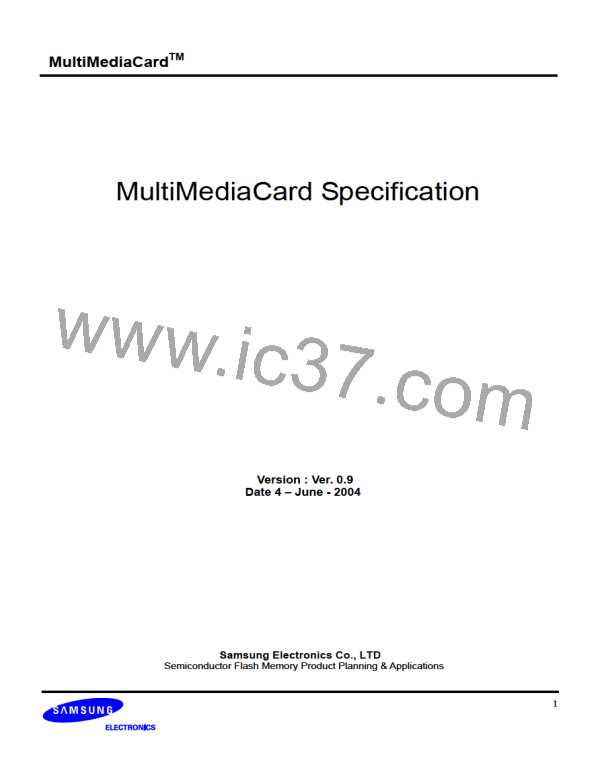MultiMediaCardTM
NDS
NBR
0
1
8
1
8Clock cycles
8Clock cycles
4.12 Error Handling
MultiMediaCards are defined as error free devices or as devices with a defined maximum bit error rate
(with external error correction circuitry). To correct defects in the memory field of the cards the system
may include error correction codes in the payload data (ECC). This correction is intended to correct
static errors. Additionally two methods of detecting errors generated during the data transfer (dynamic
errors) via a cyclic redundancy check (CRC) are implemented.
4.12.1 Error Correction Code (ECC)
The MultiMediaCard is free of static errors. All errors are covered inside the card, even errors occurring
during the lifetime of MultiMediaCard are covered for the user. The only effect which may be notified by
the end user is, that the overall memory capacity may be reduced by small number of blocks. All flash
handling is done on card, so that no external error correction is needed.
4.12.2 Cyclic Redundancy Check (CRC)
The intention of the ECC method is to protect the MultiMediaCard against permanent storage failures
in the memory field of the card. To protect the data against errors generated during the transport over
the MultiMediaCard bus dynamically, an additional feature is implemented: the cyclic redundancy
check (CRC). Following the MultiMediaCard standard, the MultiMediaCard uses two different CRC
codes to protect the data and the command/response transfer between card and host. Unlike the ECC,
the CRC is intended only to detect transfer errors and not to correct them “on the fly”. When a CRC
error is detected the host has to react. This is normally done by repeating the last command. The first
CRC code is intended to protect the command and response frames. They are also used to
synchronize the data stream.
One CRC is checked in the MultiMediaCard for every command. For each response a CRC is generate
in the MultiMediaCard. Each data block read from the MultiMediaCard will be succeeded by
redundancy bits generated with the second CRC.
Both CRCs are mandatory for the card and the host.
• CRC7
The CRC7 check is used for all commands, for all responses except type R3, and for the CSD and CID
registers. The CRC7 is a 7-bit value and is computed as follows:
generator polynomial: G(x) = x7 + x3 + 1
M(x) = (first bit) * xn + (second bit) * xn-1 +...+ (last bit) * x0
CRC[6...0] = Remainder [(M(x) * x7)/G(x)]
All CRC registers are initialized to zero. The first bit is the most left bit of the corresponding bit string (of
the command, response, CID or CSD). The degree n of the polynomial is the number of CRC protected
bits decreased by one. The number of bits to be protected is 40 for commands and responses (n = 39),
and 120 for the CSD and CID (n = 119).
• CRC16
The CRC16 is used for payload protection in block transfer mode. The CRC check sum is a 16-bit
value and is computed as follows:
65

 SAMSUNG [ SAMSUNG ]
SAMSUNG [ SAMSUNG ]